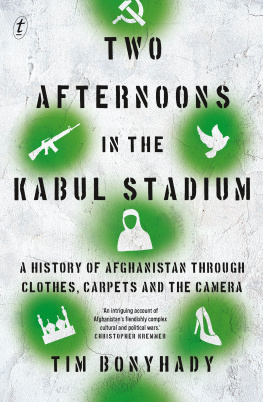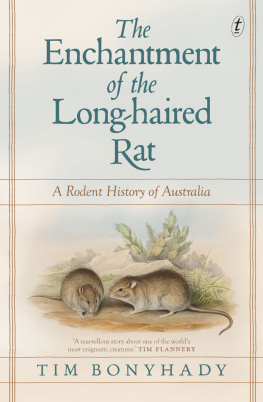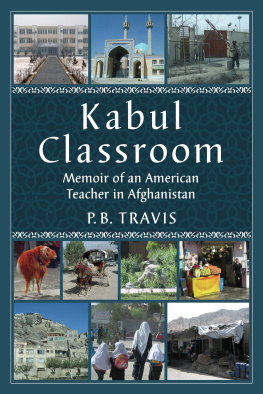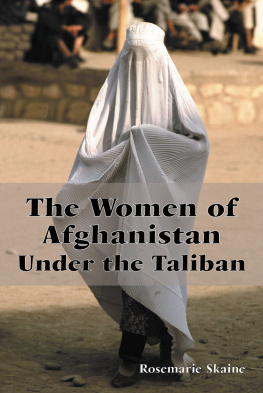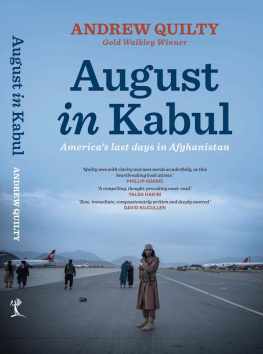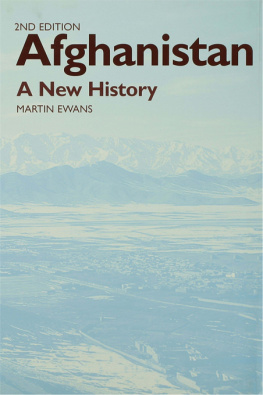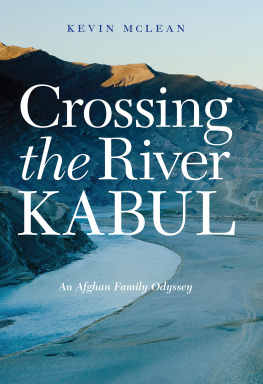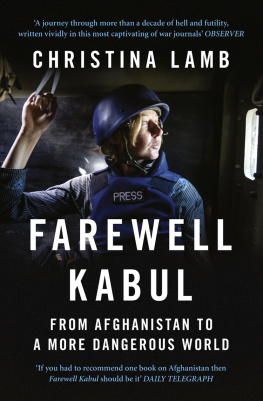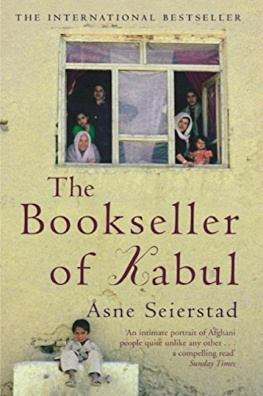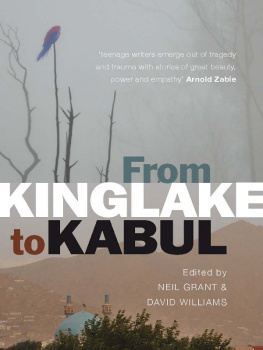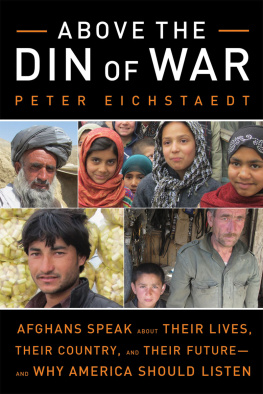From the complete coverage of chadaris to mini-skirts, and back again. From ancient carpet designs to woven depictions of tanks and Kalashnikovs. From photographs of unveiled women to an image of horror-the execution of a kneeling woman known as Zarmeena, videoed covertly by one of the few watching women. This remarkable book provides a history of Afghanistan through the visual.
The Kabul Stadium looms large because it was there, one afternoon in August 1959, that women first appeared in western dress at a celebration of Afghanistans independence-a turning point, not only for women in Afghanistan's cities but also for the country itself, symbolising its embrace of the modern. It was also there, one afternoon in November 1999, that the Taliban killed Zarmeena.
Two Afternoons in the Kabul Stadium offers both a new way of seeing Afghanistan and a new way of understanding it.
Tim Bonyhady's books include the award-winning Good Living Street, The Colonial Earth and The Enchantment of the Long-haired Rat. He has curated two landmark exhibitions of Afghan war rugs.
For Ned Bonyhady
1919 Amanullah becomes King of Afghanistan and initiates the Third AngloAfghan War, which secures Afghanistans independence from Britain.
1927 King Amanullah and Queen Soruya embark on a Grand Tour, travelling via India and Egypt to Europe.
1928 On returning to Kabul, Amanullah introduces a new dress code for women as part of attempting to modernise Afghanistan and provokes an uprising led by Bacha Saqqao.
1929 Amanullah and Soruya go into exile after he loses his throne to Bacha Saqqao, who, in turn, is defeated by Amanullahs former minister for war, Nadir Khan.
1933 Following Nadir Shahs assassination, his son Zahir Shah becomes king, with little power.
1959 Prime Minister Mohammad Daoud initiates another attempt to modernise the clothing of Afghan women, starting at Kabuls Ghazi Stadium.
1963 Daoud steps down as prime minister and King Zahir Shah becomes Afghanistans effective ruler for the first time, continuing Daouds modernising agenda.
1973 While Zahir Shah is in Italy, Daoud stages an almost-bloodless coup and declares himself president of the new Republic of Afghanistan.
1978 Members of the Peoples Democratic Party of Afghanistan seize power, killing Daoud and many members of his family, resulting in communist rule led by Nur Mohammad Taraki.
1979 Tarakis deputy, Hafizullah Amin, has Taraki murdered and briefly succeeds him before the Kremlin, seeking to stabilise and ameliorate Afghanistans communist rule, sends its forces to kill Amin and install another communist president, Babrak Karmal.
1980 The US and Saudi Arabia, which have already been funding the communists opponentssoon usually known as the mujahideenmassively increase this funding, transforming Afghanistan into a prime site of the Cold War and of Islamic fundamentalism.
1986 The Kremlin installs yet another Afghan president, replacing Babrak Karmal with Najibullah, in a successful attempt to strengthen communist rule.
1988 Mikhail Gorbachev starts withdrawing Soviet troops from Afghanistan.
1989 The Kremlin completes its military withdrawal but, with continued Soviet funding, Najibullah retains power.
1991 The USSR fragments and the Kremlin ceases its funding.
1992 Najibullah resigns, the mujahideen reverse some of the modernising measures of their predecessors and battle each other, especially for control of Kabul.
1994 A new force, the Taliban, takes the southern city of Kandahar and introduces a range of laws which, in many respects, are much more conservative than those in place in 1959 when Daoud initiated the unveiling at the Ghazi Stadium.
1996 The Taliban take Kabul, execute Najibullah, and extend their conservative regime to most of the country though implementation of many of their lawsincluding their dress codes and prohibition of images of living creaturesis only partial.
1998 After imposing public punishments episodically, the Taliban begin to do so regularly at the Ghazi Stadium.
1999 The Taliban impose far fewer punishments at the stadium but, for the first time, execute a woman.
2001 In response to al-Qaedas attacks of 9/11, Washington ousts the Taliban and installs a new Afghan government led by Hamid Karzai.
There were once flappers in Kabul. A few were westerners, married to diplomats posted to King Amanullahs court. Most were Afghans, led by Queen Soruya, who embraced western dress while travelling in Europe early in 1928, then maintained her flapper look on returning home. When Amanullah began liberalising dress codes that summer, women from Kabuls elite followed Soruyas example, sometimes wearing small veils below their eyes, sometimes going without. But by the start of 1929, the Kabul flapper was no more. Facing an armed uprising, Amanullah abandoned dress reform, hoping to reduce opposition to his rule. Then he fled with Soruya who was likened to Helen of Troy: a woman who took off her veil and started a war.
For the next thirty years, most Afghan women in Afghanistans cities wore chadaris, the local counterpart of the burqa, which extended from head to toe, with a mesh over the eyes. But in 1959 the government of Mohammad Daoud orchestrated another unveiling during Afghanistans main independence celebrations. The venue was Kabuls only stadium, one of many public forums previously barred to Afghan women. With the stands crammed with men, a small group of women from Kabuls elite appeared one afternoon in the royal pavilion wearing headscarves with western outfits. Daoud had ordered them to attend, though most if not all were eager to do so.
Daoud wanted a mass audience; hence his use of Kabuls biggest arena during a holiday period. But because photographs of Queen Soruya in western dress had been used to incite rebellion in Afghanistan in 1928, Daoud did not have the unveiling in 1959 either photographed or filmed. While the unveiling still faced intense opposition, it proceeded, leading many urban Afghan women to embrace western dress for more than three decades. For much of this period, the unveiling at the stadium was recognised as the start of a new era for Afghanistan, symbolising its embrace of the modern. For a few years, the unveiling was commemorated annually.
Now the stadium is remembered as a place of public punishment. The unveiling has been eclipsed by the Talibans execution of a woman known only as Zarmeena for murdering her husband. One afternoon in 1999, before a crowd consisting principally of men, including a few journalists working for the international press invited by the Taliban, Zarmeena knelt on the edge of the penalty box in a chadari and a man with a Kalashnikov shot her in the back of the head. As usual, when journalists attended punishments at the stadium, they immediately filed reports. Since Zarmeena was the first woman executed by the Taliban in Kabul, they wrote more than usual. But because of a Taliban prohibition, they did not photograph or film what occurred.

